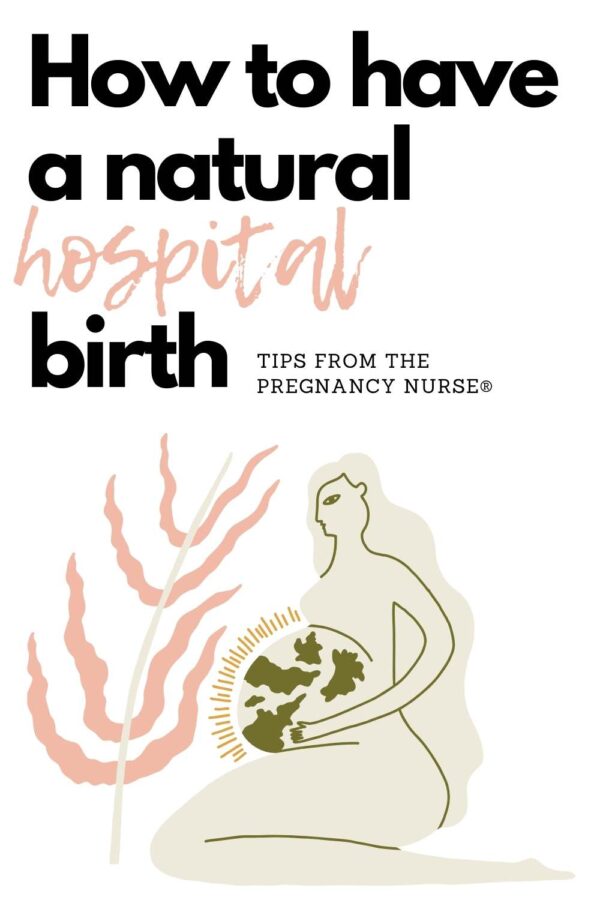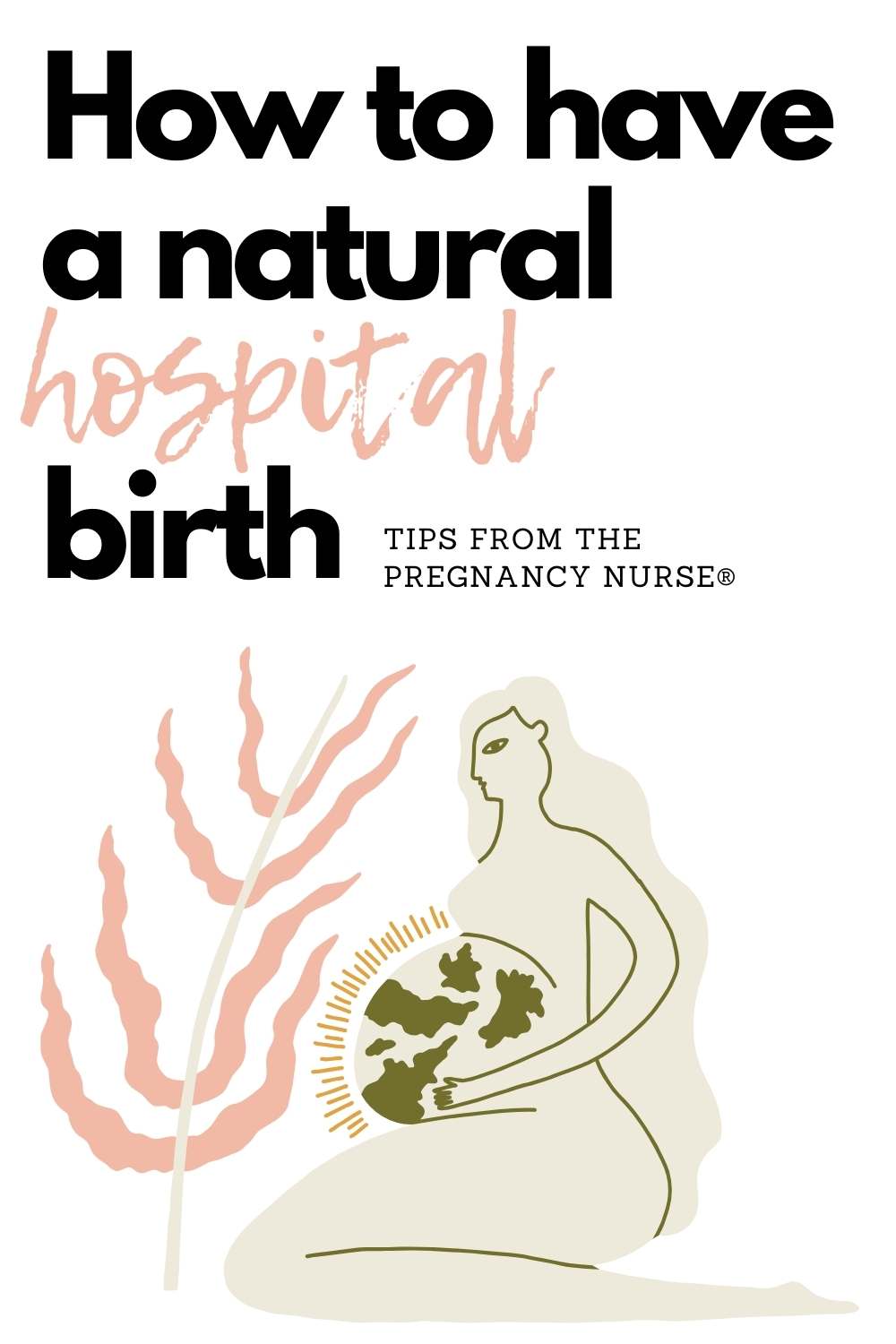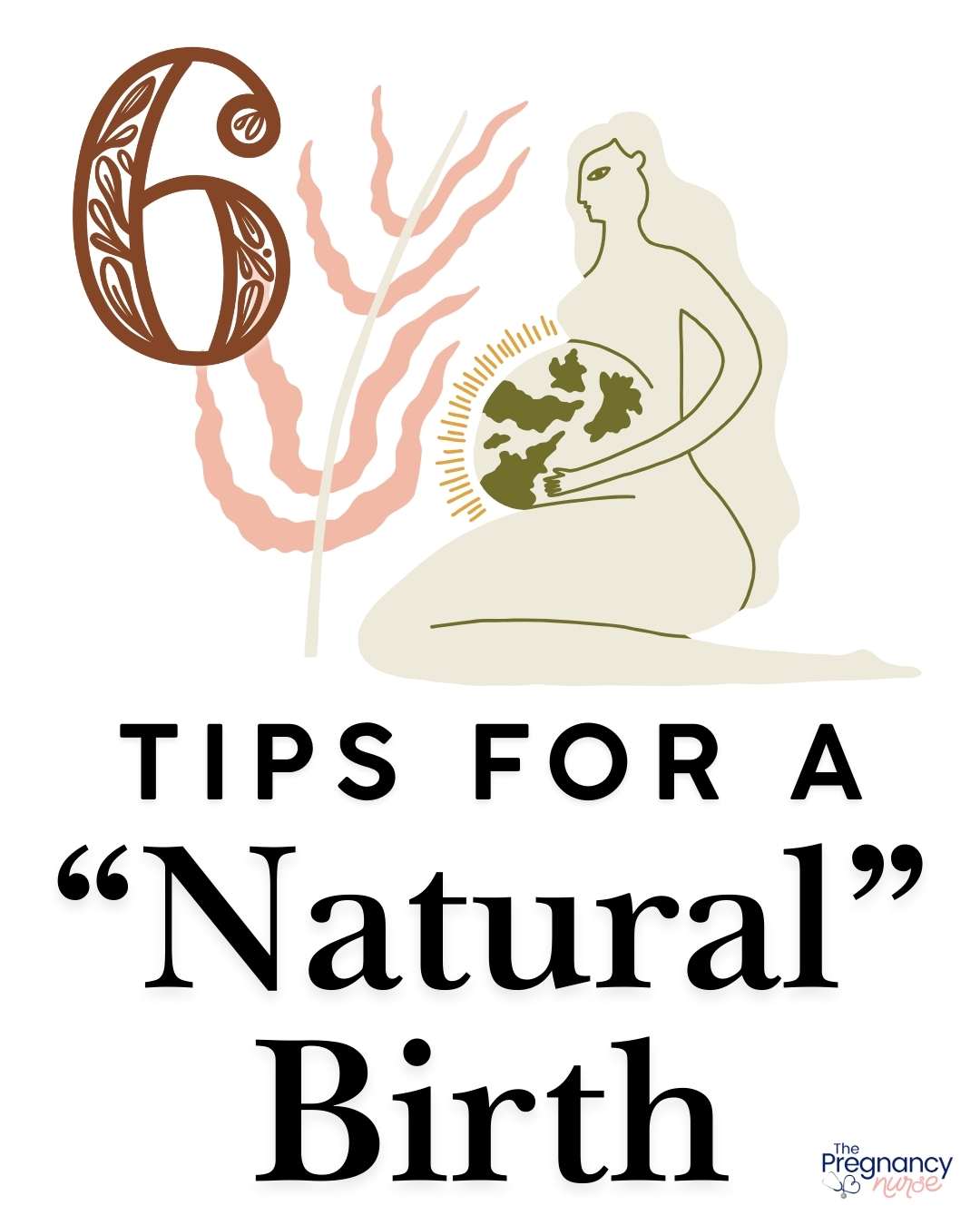📣 YOU are clearly getting prepared for pregnancy, birth & beyond — but do you wish your partner was more involved (looking for a teammate rather than just a cheerleader)? Couples love THIS! 💛🧡💚
I often hear people wanting to know how to have a “natural” birth at the hospital. It’s important to know that “natural labor” or natural childbirth looks different for everyone. Some people prefer the terms holistic of physiologic birth. Either way, this article is going to help you clarify what that means for YOU and give you tips to achieve the birth you’re hoping for.
One of the worst things you can do is “tie” yourself to a specific type of birth. It’s SMART to have hopes and desires, but with something SO unpredictable as birth you need to remain flexible.

Ok, so — what are most people talking about when they say a “natural birth”? Most people equate it with:
Unmedicated Birth
There’s two main types of medications given surrounding birth (there are more than these but most often those are given for specific health or labor issues which we will talk about later in this post — so keep reading).
Induction Medications
Most often people hoping for a “natural” birth are hoping not to be induced. An induction of labor is when we start labor at the hospital. Either by mechanical means (like a foley bulb) or medications like Pitocin or Cytotec.
This can be done for a variety of reasons, or after 39 weeks, in most places, people can choose to be induced — which is called an elective induction.
Clearly, if you’re hoping for a natural labor you’d refuse an elective induction and think very deeply if you need to be induced for whatever medical reason they are giving you.
Understanding the 3rd trimester testing is SO important (and the majority of people have some 3rd trimester testing). You need to know what the test it testing for to understand the results, we talk about all of that in here. So many people just skip that and take the results as a reason to be induced, but it’s a really important time to advocate for yourself and your priorities.
At the same point, if you don’t want to be induced in the hospital (one of the few ways to guarantee to go into labor) then you should also not be trying random weird methods to go into labor at home. If you’re really wanting nature to take it’s course, allow it to do so.
If you want to be induced (and there is NOTHING wrong with that — pregnancy is MISERABLE in the end) then ask them about that. Keep in mind that while castor oil is available without a prescription it doesn’t mean that it’s safe.
This is one of the important times to NOT be tied to a specific plan. If you’re at your wit’s end and your cervix is favorable and you just want to be done — is there truly a reason to wait? I can’t answer that, but I would ask you to think about that deep inside.
Want to know more about inductions? — check out these posts:
- 5 Things NOT to do Before Your Induction
- Inducing Labor at 39 Weeks: Pros and Cons
- 5 Reasons to NOT Get Induced
- What Happens if Your Induction Doesn’t Work?
- 6 Things to Know About Your Fetal Growth Ultrasound
And, if you’re considering an induction, be sure to grab my checklist of things to review with your provider:
Ok, here’s the other medication most people want to avoid:
Pain Medications
Of course, those come in several forms:
IV pain medication, nitrous oxide or the epidural.
IV pain medication is VERY much mis-understood and I did a whole podcast on it. It’s a valid option if you just need something to get you through those last few centimeters and get some rest.
Many people go-in thinking they want a natural birth and find a nice compromise in either IV pain medication or nitrous oxide.
Once again — smart to not be so tied to your birth plan that you end up being so tired and miserable during labor you can’t even enjoy that new baby — compromise is a win!
The Epidural
The majority of women in the United States end-up getting an epidural. I would say that the minority come-into labor planning to get one (although that’s probably pretty close).
I would agree that the epidural is very much not natural, but many women find that it increases their joy in birth, they’re able to rest more and enjoy the process more.
I also think that sometimes your body just can’t relax with how much pain you’re in, and your cervix is part of your body. Sometimes that epidural helps you entirely relax and BOOM it’s time for baby.
I am not going to dive too deeply into the epidural here, but I have a ton of posts on it:
- Epidurals During Pregnancy & Labor
- How Many CM Do You Need to Be to Get An Epidural?
- Weird Side Effects from The Epidural That No One Talks About
- What to Do If You Can’t Decide if You Want an Epidural or Not?
- Is a “Walking Epidural” A Real Thing?
I’ve also set-out some easy ways to understand your pain management options you can grab here:
Ok, now that you’ve hopefully defined what “natural birth” means for you — let’s talk about some tips to getting yours:
Birth Tips for a Natural Birth
These certainly are not ALL my tips, but I wanted to give you a few of them here. If you want more I’d recommend taking this.

Understand Third Trimester Testing
Once again — I think it’s SO important to understand that testing you might get at the end of pregnancy.
- Know what the test will include so you’re not caught off-guard
- Know what it’s measuring
- Know how to talk to your provider about why they ordered it (knowing more about the test makes you feel SO much more confident in this discussion)
- Know the basics of what the results mean, so you can dive deep with your provider on what the risks/benefits are of moving forward with your plans.
This is an area entirely forgotten by a lot of people.
They just think that if your provider offers an induction you should take it. BUT, that’s not the case.
There are VERY FEW clear-cut cases in labor and delivery. Most often you can have the test repeated in a few days, see how you’re feeling and just take it a step at a time.
I talked with one of my favorite OB’s about this on my podcast — it is a GREAT listen:
Be SURE that when you take a birth class, that it includes these big choices leading up to your due date and labor. Your education does NOT start at labor. I recommend this class — it’s fast, affordable and quick. Plus it really prepares you from pregnancy all the way through your first few months after baby is born.
Have you checked a birth class off your to do list✅? I have a few I recommend:
❤️ Best class for couples {per BabyList}
👩💻 Best class available on demand
⚡ Best class JUST for pain management
👶 Best Postpartum-Only Prep
❤️🧡💛💚💙💜 My favorite class is here.
Now is the time to get started!
Not Using Medication Labor Tips
This is the one that most people jump to in their brain. My best three tips for this are:
Practice labor breathing early and often (it is taught in that class)
Labor at home as long as is safe (knowing how to labor at home is tricky and you need an expert to really talk you through what to do, and how partners can best assist you during this time (that’s their time to shine).
Bad news time: There often isn’t a magical “this is when you go to the hospital” trick that works for everyone. Check out my post on how to know when to go to the hospital for more on that.
Take it a step at a time. It’s easy to think that the pain is going to get exponentially worse, but sometimes it doesn’t.
The good news is that most medical birth pain management can happen fairly quickly (especially IV meds) — so if the pain does start to swallow you, you have options. BUT don’t get pain medication just because you’re afraid of what the pain will become.
I have lots of things to do at home, and ways to breathe and have your partner help support you in here. But, those are three good tips to get you started.

Perineal Massage
I honestly had read a few studies that had soured me on this — but I recently did a deeper dive into perineal massage and how it can make for easy labor (or at least easier labor).
I would recommend reading my full post on perineal massage, but here are a few things to know:
- It has been shown to reduce larger tears/episiotomies
- It has been shown to decrease birth trauma
- If you’ve already had a baby the benefits are a bit different
Honestly, getting a bit more familiar with a part of your body you’ve avoided most of your life isn’t a bad idea either — BUT, it’s not for everyone so be sure to ask your provider if it’s right for you and they may even have some tips (and some packets of lube) to make it easier.
Understand Reality
I often say that I thought being a mom with a newborn would be like having a new purse I just hauled places. I was super wrong. I think that the reality of pregnancy, birth (as well as hauling around something that is WAY more complicated than a new purse) really hit hard for a lot of people.
So, I would encourage you to actually understand what real birth looks like.
Unfortunately, you’re not going to get that from:
- The media — honestly, so bad — so, so bad for the VAST majority of instances
- Birth stories — people have a selective memory ESPECIALLY on social media, it’s bad
- Your provider — they really just don’t have time to explain all of it.
I’d 100% recommend taking a birth class (also called prenatal classes, or childbirth prep). I recommend this one but you definitely want one:
- Taught by an actual expert (I prefer a labor and delivery RN over doula or childbirth educator because they really understand reality and complications)
- Information begins for during pregnancy (complications that should trigger a call or a visit and 3rd trimester testing) and be informative all the way through your first weeks/months postpartum
- Should cover common interventions so you’re not caught off-guard and you know how to talk with your providers to make the best choice for you
Far too many classes only talk about pain management, or pelvic floor health (?), but most people find that talking with their team and making choices to be the hardest part of having a baby — so you want to be SURE that yours includes a lot on that as well.
This one even has a provider communication simulation bonus that people really find helpful.
Natural Birthing Plan
Ok, I 100% recommend having set in your mind what you’d like your natural birth to look like. Not what it WILL look like, but what you’d like.
Kind of like a vision board — pie in the sky thinking. That sort of thing. Something you think about purposefully and then leave it in God’s (or mother nature, or whoever’s) hands.
It also really helps your labor team clarify what a “natural birth” looks like for you.
I have a TON of posts on hospital birth plans, including a natural birth plan — but I think your best bet is to take my quick (and free) birth plan series. It comes with a birth plan template, some options and I walk you through how it can be the most helpful to both your team and you. You can easily get it right here:
I will give you this one pro tip:
Discuss that birth plan early and often. Once you have it done (or even mostly done) take it to your appointments to talk through with your provider. SO important, and an easily-missed step.
Want more on birth plans? — check out these posts:
- What a Birth Plan Can ACTUALLY Do For Your Birth?
- Planning for Bump to Bassinet: Must-Have Resources for Expecting Parents
- Your Guide to Your Postpartum Plan with Free Template
- Birth Plans: Wish Lists, Preferences, and Realities
- Birth Plan Worksheet: Flexible Birth Plan for Success!
Natural Baby Delivery Options
Ok, at delivery there are a few more specific options that not a lot of people think about.
How to Push
You’ll hear a lot of talk about:
- Spontaneous pushing
- Patient directed-pushing
- Not being on your back.
I have a whole post that talk about how to push out a baby. But, if you want the VERY SHORT cliff notes, here it is:
Do a variety of things, and see what works for you. Continue to vary it until birth.
One of the weird expectations is that pushing doesn’t take long — I have a whole post on how long pushing takes, but the reality is it’s often a couple of hours+. Another one of those expectations meets reality points that I help with in here.
Using Forceps/Vacuum
Many people don’t know about forceps and vacuums. I go over both in detail in here (lesson 5), but your provider may recommend some assistance from their end with these items close to delivery.
They definitely have risks and benefits and you should understand them before you employ them.
They aren’t used often, but many people don’t think of them as “natural”. However, they can prevent cesareans or help baby out in situations there at the end. I’m a fan when used properly.

Delayed Cord Clamping
This one gets a lot of talk online. You’ll hear some people saying to wait til’ it stops pulsating, or til’ it’s white.
Standard of care is waiting 30-60 seconds. I haven’t seen many studies that show true benefit beyond that point.
The other reality is that many cords are pretty sure and you can’t really see baby until that cord is cut — so it’s nice to balance both baby getting the blood flow and being able to hold and love something you’ve worked so long for.
Fun Fact: As soon as the cord is in air it starts to clamp off. So, it’s not like blood just flows easily until it’s clamped — mother nature has set it to “stop” so baby isn’t harmed if it breaks, etc.
Vaccines & Medications for Baby
You’re going to have the choice of a few vaccines/medications for baby after birth:
- Hepatitis B Vaccine
- Vitamin K shot
- Erythromycin ointment
While some might not say these are “natural” I think you’ll find that often “natural” ended in death for some babies (think about our pioneer ancestors and the infant death rate back then). I would encourage you to talk with your OB and prospective pediatrician about these options to see what’s right for you. My kids got all 3 for a variety of reasons, mostly that I didn’t see any harm and I did see a lot of benefit if they became necessary.
“Natural” is such a weird term and I want it to mean that you’re balancing allowing mother nature to take her course, while also utilizing resources of science and technology to have the best outcome. It doesn’t mean that you’re alone in the forest having your baby and biting through the cord on your own and then eating the placenta. That seem the most natural, but I’m guessing that’s not what you mean. And also, ew 🤮.
I do want to say that as a nurse I am a HUGE believer in as little intervention as possible unless there’s some big benefits. I think most practitioners feel this way — so using those people on your team to talk things through can be super helpful.

Pregnancy Problems Affecting Natural Birth
Ok, now it’s time to talk about those problems that might affect “natural” birth.
Maybe you have preeclampsia and you need to be induced, that induction takes a long time as you’re early and you end-up wanting an epidural. You’re also so tired you end up needing a little help at the end with a vacuum. BUT, you get your delayed cord clamping and a beautiful hour of skin to skin after birth.
Maybe your water breaks early and you’re just so tired by the time labor kicks in you need something for the pain to get some rest. Baby ends-up needing some antibiotics and a stay in the NICU, but you’re able to start pumping right away and spend lots of time in the NICU with them, even if it’s not what you hoped for.
There are a LOT of things that can happen in pregnancy that may change what we value at that point in time.
You likely value a healthy baby (and a healthy you, although you don’t think about it as much) over almost anything when you really think about it — and that’s OK. That’s natural and normal. I believe your healthcare team also values that.
I honestly think that birth is very similar to driving on the freeways of Southern California (if you’ve never been there — think MANY freeways and LOTS of traffic). There are MANY ways to get to your destination. The may not be the way that you initially thought of, but it gets you where you want to go.
If you get on the freeway thinking I am ONLY going to take the 505 today, you may be waiting a LONG time if there’s an accident on there. You may not even get to your destination safely. Or, you could take a side street, or another freeway that would get you there close to on time and safely.
This is NOT to say that healthy mom/healthy baby is the only thing that matters but I do think that:
- Having realistic expectations of what “natural” may end-up looking like
- Talking through your plans early with your providers (doctors and nurses) so they can alert you to any “traffic issues” they see coming up
- Focusing on the positive in the situation you are given
Those are the KEYS to a successful birth.
Let me help you get those expectations in check. Let me talk with you about options, as well as interventions that may happen so you’re not caught off-guard thinking labor prep is just about pain management.
As you can see it’s so much more, and I would be honored to be the one to walk you through it.
The Online Prenatal Class for Couples is:
- Quick – the main class is under 3 hours
- Affordable – about 66% less than the average cost of birth classes
- Thorough – all of my experience prepares you for what you NEED to know from bump to bassinet.
oh, an did I mention it’s there to turn your partner from a cheerleader into a teammate? Yup, it’s pretty great.

Want to do a vibe check before diving into the whole thing with me? — check out my free labor pro tips. It’s your first step toward getting in the driver’s seat of your birth.
Don’t miss my great big post on everything you need to know about birth classes << for more information this important subject!











 Hospital Policies You Can NOT Say No To.
Hospital Policies You Can NOT Say No To.
